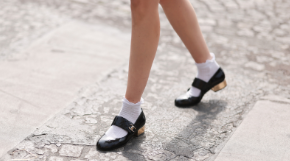From gracing the feet of 1900s schoolchildren to gaining an insurmountable presence in the theater world, Mary Janes – the iconic rounded, buckle shoes – have been reinvented countless times over the decades for countless purposes. A symbol of girlhood and femininity, the classic black leather style has expanded its horizons to feature bright, flamboyant colors and striking patterns and has become a trademark of many fashion trends. While the popularity of Mary Jane shoes has been steadily increasing over the past few years, especially among younger generations, its extensive history stretches back to medieval times.
Evidence of shoes similar to Mary Janes has been found to exist in times as early as the 16th century, during the reign of King Henry VIII. However, they only gained major recognition and widespread fame in the 19th century. Mary Janes – then called bar or doll shoes – were common among young children since the strap across the instep was simple and comfortable. They were worn by both boys and girls and were easy to put on and take off. Their iconic name wasn’t coined until 1904, when the Brown Shoes Company licensed the name from the Buster Brown comic series by R.F. Outcault. The shoes were named after Buster Brown’s best friend, Mary Jane, who wore shoes nearly identical to the “bar” or “doll” shoes of the day. Despite the comic’s controversies and the license’s expiration, the celebrated name still remains.
In the 1920s and 1930s, Mary Janes became most popular for women, as they were glamorous and excellent dancing shoes for late nights at jazz clubs. With the higher hemlines of women’s dresses, shoes became statement pieces that were meant to be shown off. More maturely called “strap pumps”, Mary Janes developed more color and patterns, from polka dots to zebra print. They were also commonly worn by flappers in the theater world and gained a presence in ballroom dance as well as flamenco.
In the 1930s, Mary Janes were promoted by legendary child star Shirley Temple, and then again in the 1960s by English model Twiggy. Their most modern appearances have been in Disney’s animated film Alice in Wonderland and the ‘90s rom-com Clueless. In the late 1990s and early 2000s, they were especially popular amongst punk rock, psychobilly, and goth subcultures. Today, however, they have made their return to fashion within the babydoll-esque aesthetic: lockets, lace, ribbons, bows, frills, and cherry lipstick. Nevertheless, Mary Janes’ presence in fashion history extends far past any individual style and, they have maintained their novelty as a cute and comfortable shoe.


ROGER S MCLENNAN • Jan 11, 2024 at 12:32 pm
I’m a Guy and enjoy wearing a Mary Jane Shoe. I’ve even had women come up and compliment me on how cute and nice they look on my feet.
And I’ll keep wearing them for many more years!
I especially love the red and white ones.
Essie Ross • Dec 29, 2023 at 7:26 pm
I Love Mary Jane Shoes I wore them to school and I still wear them